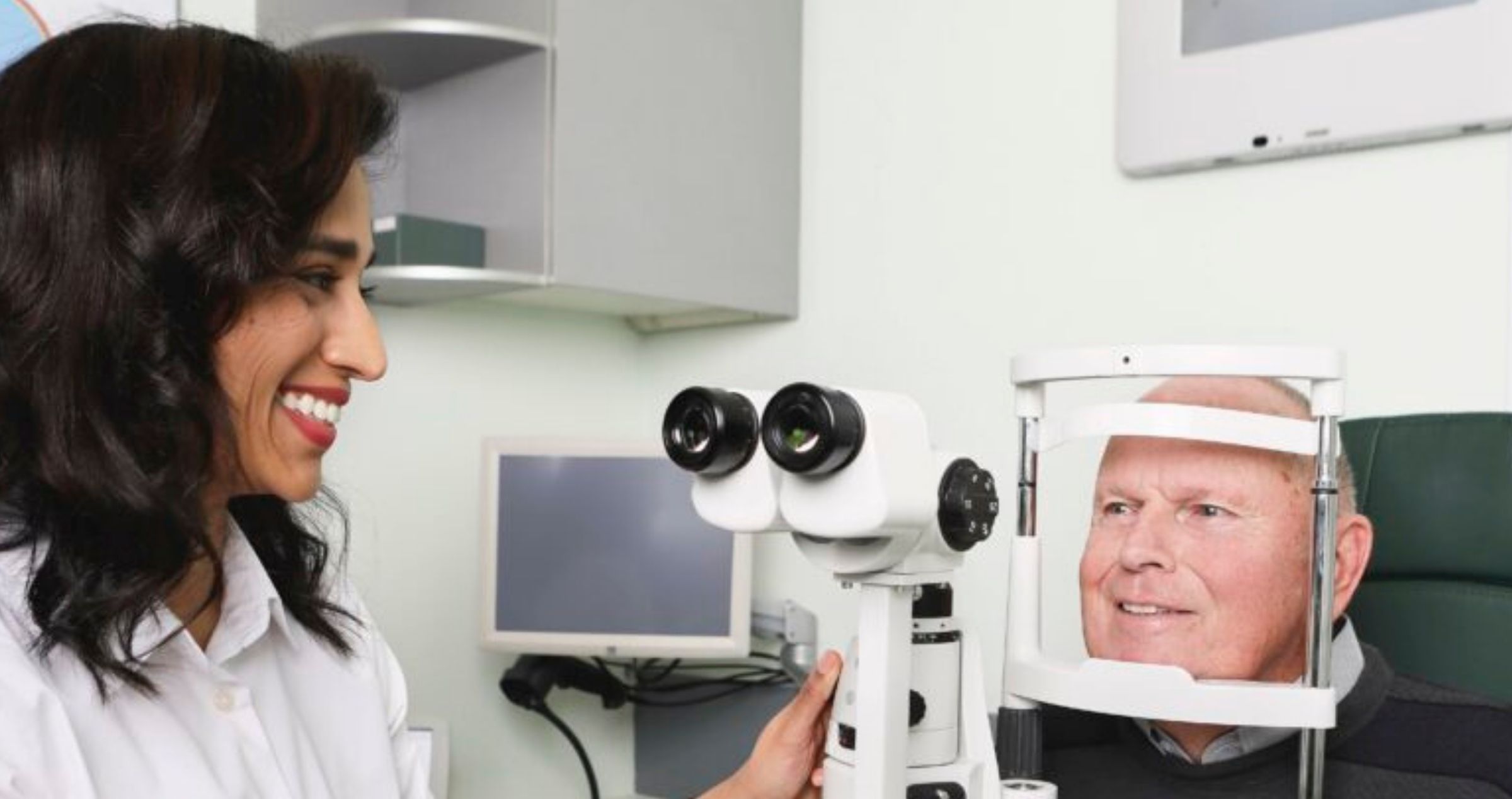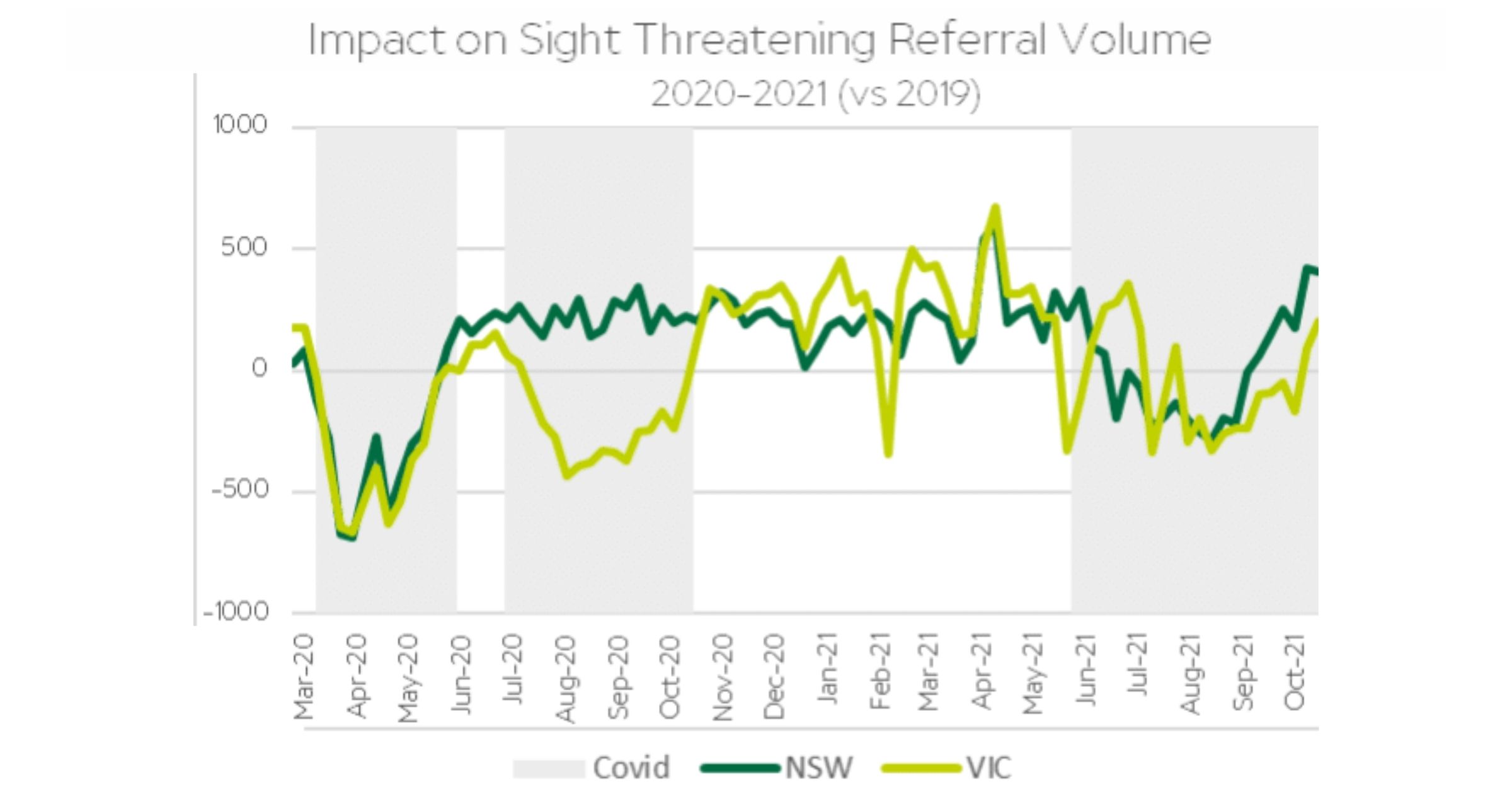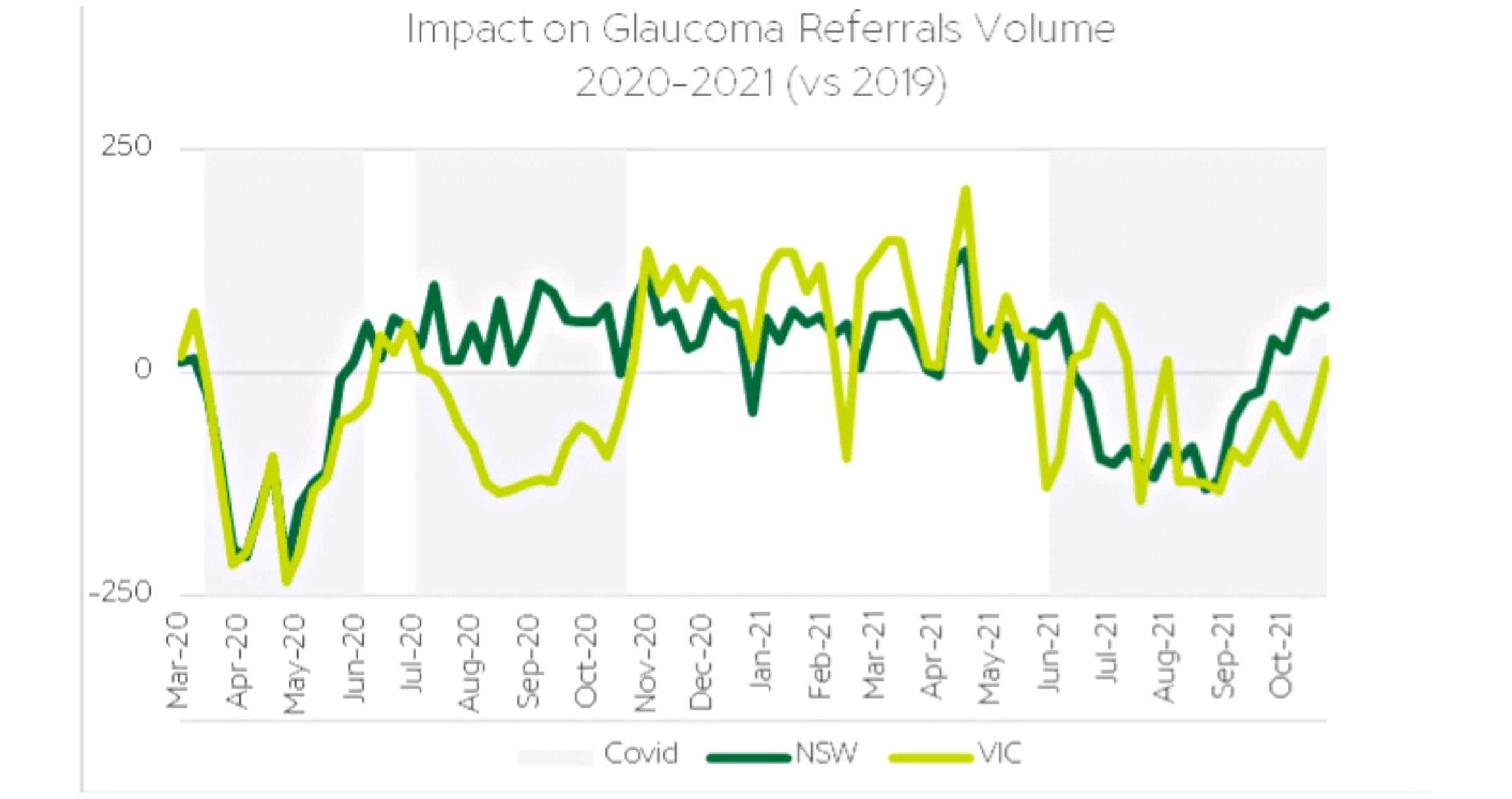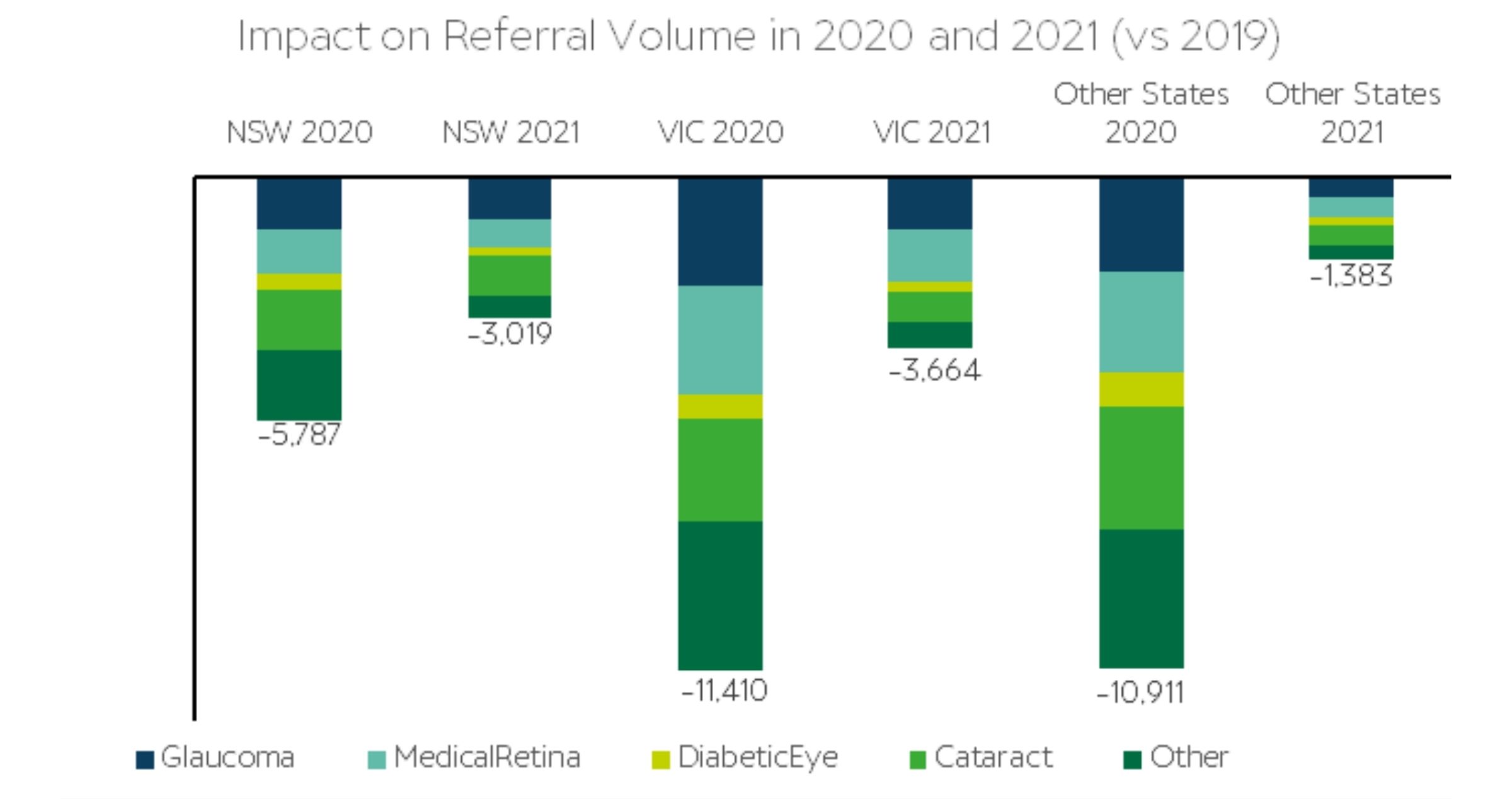Share
New data paints a worrying picture of how difficult it was for patients in Australia’s most locked-down states to access optometry services in the past 18 months, writes Specsavers ANZ director of optometry Dr Ben Ashby.

The past 18 months have been anything but ordinary. COVID-19 restrictions and prolonged lockdowns across states and regions have impacted access to eye care across Australia, restricting optometrists from providing routine care.
This has had, and will undoubtedly continue to have, an impact on eye health across Australia. With almost everyone likely to experience an eye health issue at some point in their life, regular, routine eye checks play a significant part in ensuring eyes stay healthy, with early changes to visual function captured quickly and corrective measures put in place.
For patients with eye conditions such as diabetes or glaucoma, regular eye checks are even more important. Consistent monitoring and management are key to avoiding preventable vision loss in these conditions, often asymptomatic in their early stages. In addition, for patients unaware they have a serious eye condition, being able to access routine eye care is critical. For many, attending a regular eye check could be the difference between halting a condition in its tracks or suffering irrecoverable vision loss.
Specsavers has been measuring the impact of COVID-19 on eye health over the past two years. This article analyses the changes in referrals over the course of the pandemic and takes a particular look at the impact across NSW and Victoria, which have endured the longest lockdown periods.
Impact on NSW and Victoria
It is fair to say that NSW and Victoria have been hit hardest by prolonged COVID-19 restrictions. Focusing on referrals for sight-threatening conditions, the data paints a worrying picture of just how difficult it was for patients to access eye care over the past 18 months.
In NSW, the early 2020 and mid-to-late 2021 periods were impacted by COVID-19 restrictions resulting in a significant reduction in patients seeking care and a corresponding reduction in referrals. This caused a large backlog of patients, who returned to practices as soon as lockdowns were lifted.

For Victoria, the picture is even more stark. The effects of restricted patient access during the numerous lockdowns of different parts of the state are clear, with obvious reductions in the number of referrals made.
Again, the rapid rise in patients attending clinics post-lockdowns points to the number of Australians with eye health issues needing regular access to care so their concerns can be managed when they arise, and not delayed unnecessarily.
Impact on referrals and urgency
Time is of the essence when a patient presents with indicators of serious health issues. For the most part, our Australian practices have remained open for essential and urgent care, but government restrictions on the care optometrists were able to provide risked compromising patients’ eye health.
By tracking referrals over a number of years and comparing this to patient volume and the prevalence of various eye conditions, it’s possible to estimate the number of referrals that would have been made under normal care conditions, but which have not been made over the past 18 months as patients have been prevented from accessing eye care.
Figure 2 highlights the COVID-19 impact on referral volume by urgency in NSW, Victoria and other Australian states in 2020 and 2021. Many thousands fewer patients were referred for specialist care during periods of COVID-19 restrictions than in the same periods in 2019. In 2020, NSW and Victoria saw declines of 49% and 40%, respectively, in the total number of patients referred for specialist care during periods of restrictions.

When looking at ‘very urgent’ referrals, this reduction was 34% and 30%, respectively. While this improved in 2021, periods of restrictions in the two largest states still saw almost a 25% decrease in total referrals compared to 2019, and 5% fewer ‘very urgent’ referrals. While it is positive to see only a small reduction in the number of patients referred as ‘very urgent’ (needing specialist management within the next 24 hours) in 2021, that there was any reduction at all speaks to the potentially devastating impact of restricting access to eye care services.
This data speaks volumes to the importance of primary eye care providers remaining open and accessible for routine care at all times.
Impact on first-time glaucoma referrals
For the past five years Specsavers has been spearheading a dedicated campaign to detect every case of glaucoma in our patients and ensure they are referred in a timely manner and supported in their treatment journey to avoid preventable vision loss.

As a result, there has been significant in-roads in reducing the seemingly accepted statistic that 50% of all glaucoma goes undiagnosed by building consistency in visual field utilisation for glaucoma suspects and performing OCT as standard for every patient. Specsavers optometrists refer 1.43% of our patients for glaucoma, a rate close to the approximate 1.5% national prevalence of glaucoma in the Australia population.
Given the positive impact this initiative has had, it is hugely concerning to see a significant reduction in the number of patients – more than 8,000 patients in total – who were not referred for newly detected glaucoma in 2020 and 2021. Both NSW and Victoria saw a reduction of more than 50% in the number of first-time glaucoma referrals in 2020 and 2021 (Figure 5).
In a normal year, many of these patients would have been diagnosed as glaucoma suspects as part of a routine eye test. Restrictions across Australia prevented many patients from accessing routine care, and it must now be a priority to ensure that this large cohort of patients are able to access eye care and are actively encouraged to return.

Impact on type of referrals
Early detection and treatment for sight-threatening conditions is paramount, making the significant impact on referral volume for patients with glaucoma, medical retina and diabetic eye diseases all the more concerning.
Both NSW and Victoria decline by more than 40% during periods of lockdown in 2020 (compared to the same period the year before) and 30% in 2021. During these periods, referrals for diabetic eye disease specifically fell by 51% in NSW and 36% in Victoria in 2020, and 26% and 28% respectively in 2021.

Referrals for other eye conditions were similarly impacted. Referrals classified as ‘other’ are those that do not fit the previous categories, including potentially life- and sight-threatening neurological and oncological conditions. While eminently treatable, delays in referral for cataract surgery can have significant negative impact on a patient’s functional independence and quality of life.
Conclusion
There can be no doubt about the impact COVID-19 has had on eye health and eye care services in Australia, with significant reductions in the number of patients referred for specialist care the result of a critical lack of access to eye care services.
As we move to the new normal, the focus for our industry must now be on ensuring access to care for all these patients who were not able to attend their regular eye test, particularly those with potentially sight-threatening conditions such as glaucoma.
We must continue to collaborate with patient education and support services like KeepSight and Glaucoma Australia to ensure that all Australians are aware of the importance of regular eye care and are actively encouraged to return if their care has been delayed.
Overwhelmingly, the negative impact on Australians’ eye health resulting from COVID-19 restrictions over the past 18 months points to a pressing need to ensure primary optometry services are always open and accessible to support patients with their eye health.
Published with permission from www.insightnews.com.au


